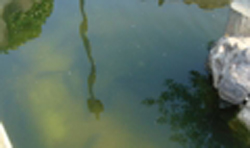
 Too Much Algae
Too Much Algae
Green water is almost always caused by an excess of unicellular algae. Some types of algae float to the top and "bloom" while others remain suspended in the water column, causing the water to look dark. A safe and economical solution is to use Hydra Crystal or Pond Clear Plus to remove the existing algae and inhibit further growth in your Koi or garden fish pond.
Too Many Fish
A pond that is overstocked with fish is prime for algae problems-excess waste (nitrogen) stimulates algae growth. Most pond gardeners calculate the number of fish for their ponds according to the surface area or the number of gallons of water it holds.
This might work to start with, but it won't be accurate for long. Remember, fish grow! Consult with your fish supplier to find out how large your fish will grow under ideal pond conditions. Don't forget to add snails, bottom feeders and if possible, some freshwater mussels to help gobble up the algae.
According to the USDA, non-aerated ponds should have no more than one, 12" fish per 10 square feet of surface area. (To calculate surface area multiply the length x width of your pond). Aerated ponds can have up to one, 12" fish per 2-3 square feet. They also recommend that the average hobbyist stay well below these guidelines.
Too Much Fertilizer
Fertilizer leeching in from the lawn or nearby flower beds can overburden the pond's nitrogen load. Avoid using fertilizers where there is a risk they will contaminate your pond water. Traditional fertilizer mixes will promote algae growth, so use a soil mix designed for potting aquatic plants when adding them to your pond. Even then, try to keep the mix confined to the plants by lining underwater pots with burlap or hessan and weighing down topsoil with gravel and rocks.
Too Much Sunshine
A lot of sun may be great for the rest of your garden, but too much sunlight streaming into your pond causes excess algae. Site your pond strategically near buildings and fences which will cast a shadow over your pond for at least part of the day.
The addition of surface plants like water lilies will also provide shade and help hold down the water temperature (algae love warm water). Add a variety of underwater oxygenating plants like Elodea, Microphyllum and Ceratophyllum (1 bunch per 8 inches square). They will help keep water oxygen levels high and algae levels low.
Too Much Tap Water
The chemicals that sterilise our tap water can actually work to increase algae blooms. When you refill your pond, try to fill part of it with some water from a stream or even another pond. Nature's water contains insects and other organisms that will help keep the algae population down.
Too Much Plant Debris
It's important to keep your pond free of decaying vegetation. As plant materials decay under water, they release nutrients that stimulate algae growth. When your pond freezes over in the winter, this decay can also cause toxic gases to build up under the ice.
Trim dead or dying foliage from plants located around the margins of your pond. If overhead trees are a problem, consider erecting a frame around the pond so you can cover it with a canopy as necessary or clean leaf debris out daily with a large net.
Not Enough Patience
It can take several months for a new pond to reach an ecological state of balance. In the first few weeks-sometimes months, your pond's water may look murky and even when in perfect balance, it won't be 100% clear any more than a pond in nature would be.
The worst thing you can do during this time is keep emptying, cleaning and refilling your pond in an attempt to achieve clear water. Every time you do this, the pond has to start over trying to reach a state of balance. Be patient! It will be worth the wait!